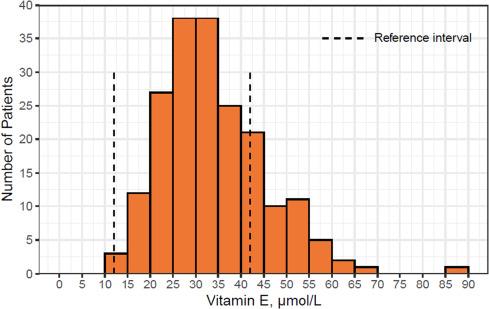Pre-transplantation vitamin E levels and acute graft-versus-host disease after non-myeloablative allogeneic hematopoietic cell transplantation |
| |
| Affiliation: | 1. Department of Hematology, Rigshospitalet, Copenhagen University Hospital, Copenhagen, Denmark;2. Department of Clinical Medicine, University of Copenhagen, Copenhagen, Denmark;3. Department of Clinical Immunology, Rigshospitalet, Copenhagen University Hospital, Copenhagen, Denmark;4. Department of Clinical Biochemistry, Rigshospitalet, Copenhagen University Hospital, Copenhagen, Denmark |
| |
| Abstract: | 
BackgroundLow pre-transplantation plasma vitamin E levels have been associated with increased risk of acute graft-versus-host disease (GvHD) after myeloablative allogeneic hematopoietic cell transplantation (allo-HCT). We aimed to investigate the association between pre-transplantation plasma vitamin E levels and acute GvHD in patients undergoing allo-HCT with non-myeloablative conditioning.MethodsIn a cohort of 194 adults who underwent non-myeloablative allo-HCT at Rigshospitalet between July 2015 and December 2019, we measured pre-transplantation plasma vitamin E levels by high-performance liquid chromatography in stored plasma samples. Univariable ordinary least squares linear models were used to investigate associations between vitamin E levels and patient characteristics. A multivariable logistic regression model was used to estimate the association between vitamin E levels and grade II–IV acute GvHD, adjusted for recipient age, donor age, female-male donor-recipient pairing, and donor type.ResultsThe median (Q1, Q3) pre-transplantation plasma vitamin E level was 32.3 (26.4, 40.4) μmol/L. No patients had a vitamin E level below the normal reference range. Vitamin E levels were higher in females (mean difference: 8.0 μmol/L, 95% confidence interval [CI]: 4.9, 11.1 μmol/L) and in patients transplanted for acute leukemia (mean difference: 6.2 μmol/L, CI: 3.0, 9.4 μmol/L). Grade II–IV acute GvHD developed in 33 (17%) patients. Patients who developed acute GvHD had similar pre-transplantation vitamin E levels compared with patients who did not develop grade II–IV acute GvHD (mean difference: 0.7 μmol/L, bootstrap CI: −3.3, 4.7 μmol/L). In the adjusted logistic regression model, an increase in the pre-transplantation vitamin E level from 26.4 (Q1) to 40.4 (Q3) μmol/L was associated with an odds ratio of grade II–IV acute GvHD of 1.17 (CI: 0.64, 2.12).ConclusionsContrary to the previously reported association between pre-transplantation vitamin E levels and acute GvHD after myeloablative allo-HCT, we did not find support for an association in patients who received non-myeloablative conditioning. The potential protective effects of vitamin E may not be efficacious in the reduced inflammatory response following non-myeloablative conditioning. |
| |
| Keywords: | GvHD" },{" #name" :" keyword" ," $" :{" id" :" pc_dsCpTGZuGI" }," $$" :[{" #name" :" text" ," _" :" Graft-versus-host disease Allo-HCT" },{" #name" :" keyword" ," $" :{" id" :" pc_tHvBADJ3Ui" }," $$" :[{" #name" :" text" ," _" :" Allogeneic hematopoietic cell transplantation |
| 本文献已被 ScienceDirect 等数据库收录! |
|

